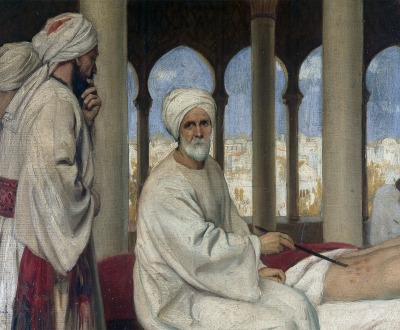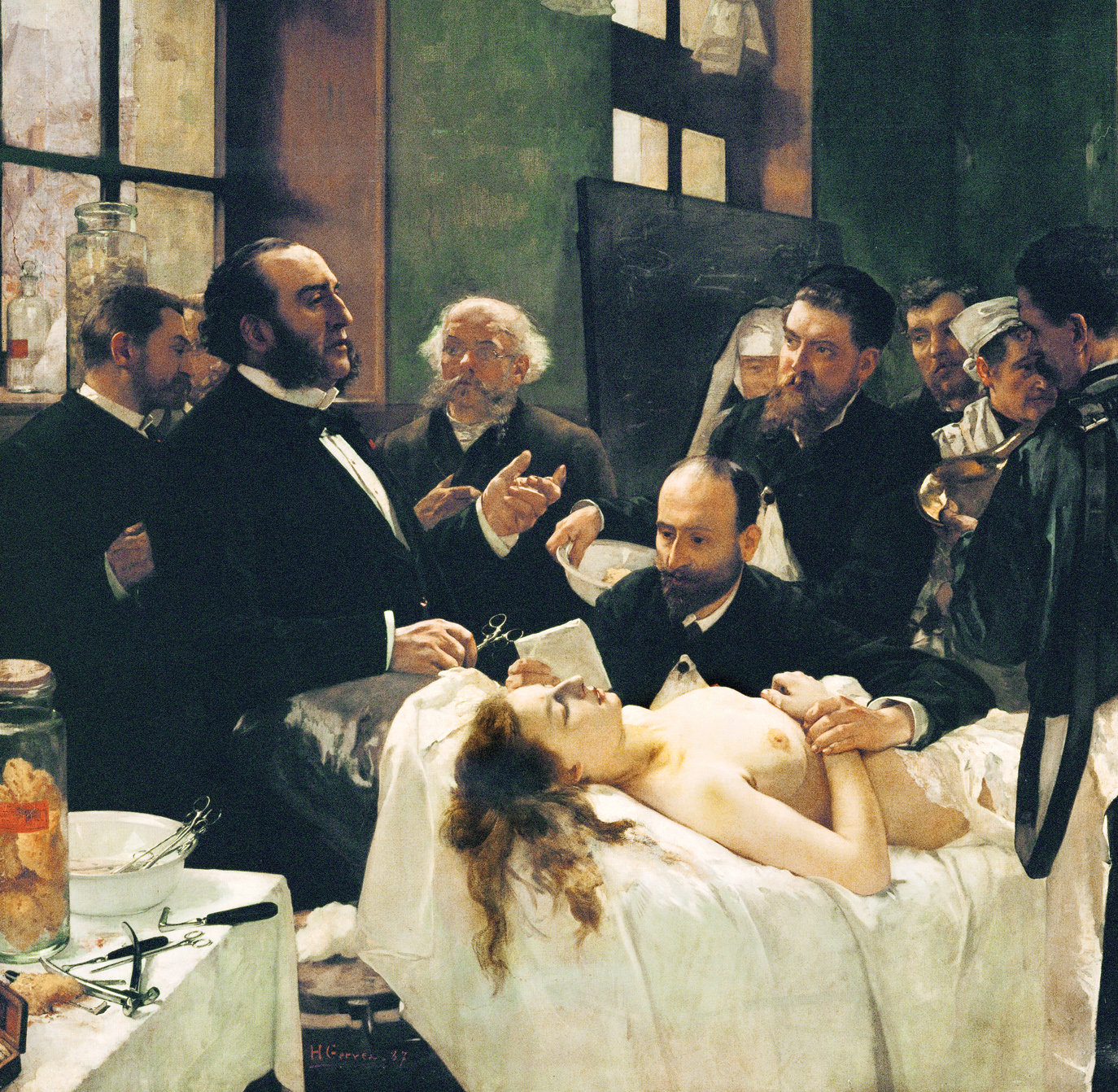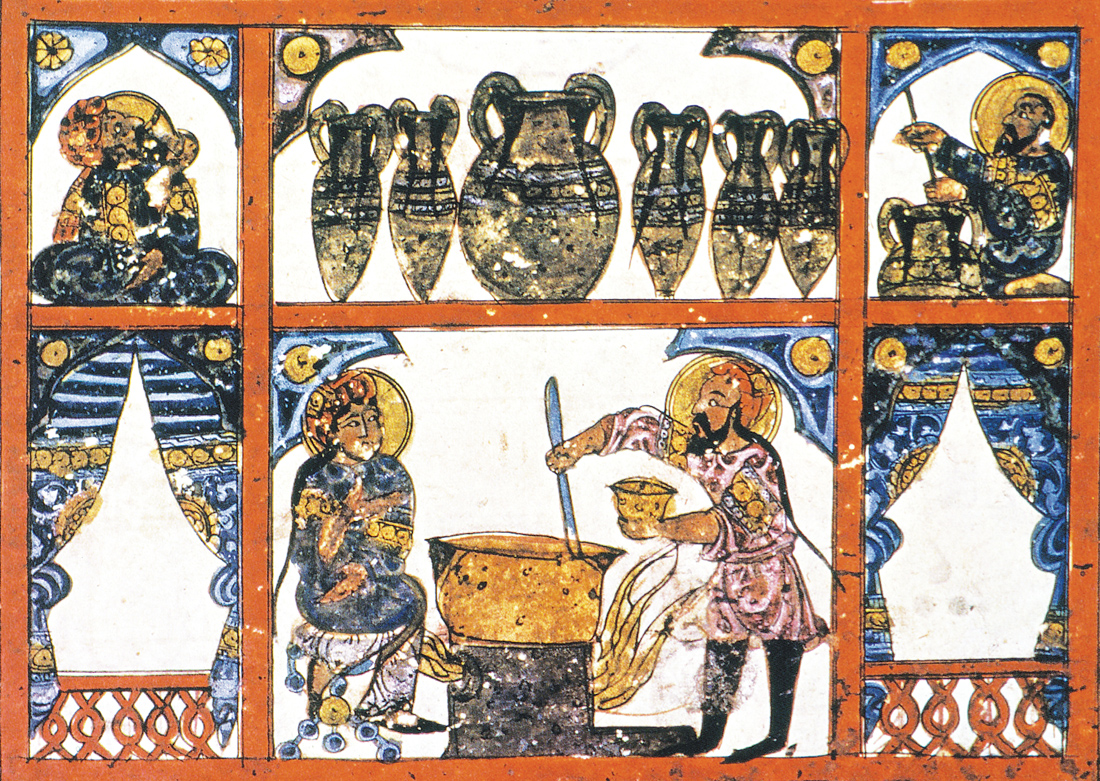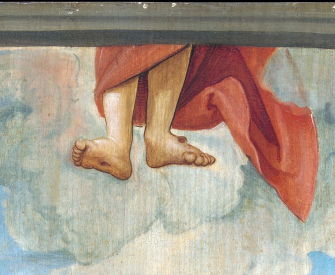Medication alone is not to be relied on. In one half the cases medicine is not needed, or is worse than useless. Obedience to spiritual and physical laws—hygiene of the body and hygiene of the spirit—is the surest warrant for health and happiness.
—Harriot K. Hunt, 1856Early Islamic Medicine
The history of Western medicine owes much to its encounters with the medieval Muslim world, yet this debt seems destined to go unrecognized and unrepaid.
By Jonathan Lyons

Albucasis blistering a patient in the hospital at Cordova, 1100, by Ernest Board, c. 1912. Wellcome Library, London.
When the Western European army of the cross brought the First Crusade to the Holy Land in 1096, the Arabs of the Near East were less impressed by the army’s religious zeal than they were appalled by its stench. The disease-ridden body of the Christian host included true believers and righteous folk but also, according to the report of the medieval chronicler Albert of Aix in his Historia Hierosolymita, “adulterers, homicides, thieves, perjurers, and robbers.” Few had any learning at all. Ignorant of even the rudiments of science, mathematics, medicine, philosophy, and sanitation, they knew nothing of the workings of that prince of medieval scientific devices, the astrolabe, which captured the movements of the three-dimensional universe on its bronze faceplate; as a result, they could not even date their most important religious holiday, Easter, nor accurately tell the time of day.
Celestial phenomena—shooting stars, ball lightning, an eclipse of the sun—terrified them. Their forebears had long since lost the ability to read Greek, thus breaking off intellectual relations with the learning of antiquity. Education had all but collapsed, save for a handful of cathedral schools clinging to innovations introduced three hundred years earlier under Charlemagne. The scholar-monks at the West’s leading center of mathematical studies, the cathedral school of Laon, had no grasp of the meaning or use of zero.
Among the greatest affront to Arab sensibilities was the Crusaders’ complete disregard for personal hygiene. Their most noble knights boasted of bathing no more than four times a year; their diet consisted largely of monotonous rations of gruel and whatever else they could forage en route; medical care frequently involved exorcism or the amputation of afflicted limbs. When the Black Death struck Europe in the mid-fourteenth century, it unleashed social chaos. With no real notion of contagion or hygiene, one-third of the population died without knowing why. The mass casualties induced a frenzy of violence, typified by the burning of Jews suspected of having induced the disease through witchcraft.

Before the Operation, by Henri Gervex, 1887. Musée d'Orsay, Paris, France.
The Book of Instruction, an informative memoir by the Syrian princeling Usama ibn Munqidh, who came to know the Crusaders in battle and in repose, records two instances in which a local physician’s sound advice was ignored in favor of Christian methodologies. In the first, the Franks simply lopped off a knight’s mildly infected leg with an axe; in the second, they carved a cross into an ill woman’s skull before rubbing it with salt. Both patients died on the spot, at which point the Arab doctor asked, “‘Do you need anything else from me?’ ‘No,’ they said. And so I left, having learned about their medicine things I had never known before.”
For six centuries the authoritative works of St. Augustine of Hippo had directed the Christian faithful to see only God’s mystery in an otherwise unknowable world. Upon his conversion to Christianity in 387, Augustine set aside his once-lively interest in art and science (“Certainly the theaters no longer attract me, nor do I care to know the course of the stars.”) and replaced it with superstition. Everyday existence was shrouded in allegorical meaning, while natural phenomena were seen—if they were seen at all—in the context of moralizing tales. The medieval bestiaries were designed to edify humans by showing them that stags, lions, birds, even rocks, were all proof of God’s wisdom and mercy and which, if properly studied, offered man a guide to Christian behavior.
Disease was viewed as divine punishment for the sins of man, rather than as a condition to be addressed or ameliorated through human intervention. The few tentative efforts to adopt the technological novelties starting to trickle in slowly from the Arab world, among them the water clock that Caliph Harun al-Rashid sent as a gift to Charlemagne in 801, were either dismissed as curiosities or condemned as Black Magic. As far as medieval Christians were concerned, God was the sole determinant force in their daily lives; there was no reason, then, to explore the nature of things—and thus, no science.
In marked contrast, the Muslims put a premium on cleanliness and dietary regime. The ritual cleansing of the body precedes each of the five daily prayers, a requirement that sparked the development of sophisticated public-water projects and ingenious engineering techniques. Religious law proscribed a number of unhealthy practices, including the consumption of alcohol, while a large collection of sayings and practices ascribed to the Prophet Muhammad, later collated as the tibb al-Nabi, or The Medicine of the Prophet, provided a general blueprint for healthy living and abstemious behavior.
By the time the First Crusade arrived in the Near East in 1096, Usama ibn Munqidh and his fellow Muslims were heirs to an Islamic civilization, built up first by the Umayyad Dynasty and then by the Abbasids in the centuries after the death of the Prophet in 632. The second Abbasid caliph, al-Mansur, relied on the advice of his royal astrologers when he began work on his new capital, Baghdad, on July 30, 762. An avid follower of the geometry of Euclid, al-Mansur oversaw the creation of a fortified Round City that would put his palace at the symbolic center of an empire radiating outward in all directions. By then, the lands under the formal dominion of the Abbasids stretched from the Atlantic to what is now Afghanistan.
Over the course of 150 years, the Arabs translated all available Greek books of science and philosophy, and Arabic supplanted Greek as the language of intellectual inquiry. Materials in the royal Persian archives together with Sanskrit manuscripts, and the Greek traditions, were assimilated and then enhanced to create a remarkable body of knowledge that can rightfully be called Arab Science. Much of this work was carried out in Baghdad at the Bayt al-Hikma, the House of Wisdom, which eventually comprised a library and an academy of scholars from across the empire. These experts also staffed the caliph’s observatory and took part in scientific experiments at his behest.
Higher education became increasingly organized from the early-ninth century, and major Muslim cities routinely featured some type of university. Another prominent Muslim educational institution was the teaching hospital, the first built in Damascus in 707. Others were subsequently established in the great Muslim cities of Baghdad, Cairo, and Cordoba. A system of medical education evolved that integrated study in the mosque with practice in the hospital. Students were required to follow a basic course of instruction: the theoretical and epistemological aspects of natural philosophy taught in the mosque; the diagnosis of fevers, the dispensing of drugs, the setting of bones, and the treatment of cataracts, learned in the wards. Completion of medical training required a dissertation and concluded with a diploma that permitted the new physician to practice.
This close affiliation of mosque and hospital is of fundamental importance to Islamic medicine and to the Islamic scientific tradition in general. Muhammad himself put great emphasis on the pursuit of knowledge, famously declaring, “Seek for science, even in China.” He celebrated scholars as the true “heirs to the prophets,” observing that “There is a remedy for every malady, and when the remedy is applied to the disease it is cured with the permission of Almighty God.”
If Islamic medicine is closely bound up with the principles of the faith, so too is it tied directly to the other sciences, to philosophy, and to the notion that knowledge is legitimate so long as it remains within the framework of the Muslim worldview as indicated in the Qur’an. The Arab philosophers devoted enormous attention to the classification of the sciences, locating both speculative and practical science within the broader spectrum of wisdom. Among the most important of these works in both East and West was that of the tenth-century thinker al-Farabi, translated into Latin as De Scientiis and widely read for centuries.
All aspects of Islamic thought rely on the relationship symbolized by the traditional figure of the hakim, or sage, who combines medical skill with intimate knowledge of the other sciences, natural philosophy, and metaphysics. The leading Arab philosophers—Avicenna, Averroës, and Maimonides—were all great physicians. The latter, a Jew who wrote his philosophical works in Arabic, served as personal doctor to Saladin, the chivalrous twelfth-century rival of Richard the Lionheart. The close links between Muslim science and philosophy also make nonsense of the notion, transposed from the medieval Western experience, that Islam and science were inevitable adversaries and that the eventual decline of the Muslim scientific tradition stemmed directly from religious persecution.
The genius of the medieval Arabs lay in their extraordinary receptivity to new ideas, that is, in their ability to fit the discoveries of foreign cultures into their own practical, intellectual, and religious demands. Islamic medicine thus combines the humoral approach of Galen and Hippocrates with the practices of Persians, Hindus, and the pre-Islamic Arabs in order to fulfill Islamic injunctions to heal the sick and comfort the ill. Muslim physicians pursued the study of human anatomy, whose wonders only strengthened their conviction in God’s infinite wisdom and power. Muslim doctors subscribed to the Hippocratic Oath, and the traditions of their art stressed that the true physician, like the true philosopher, must be pious and upright. A twelfth-century Persian treatise on the skilled professions notes, “The physician should be of tender disposition and wise nature, excelling in acumen, this being a nimbleness of mind in forming correct views, that is to say, a rapid transition to the unknown from the known.”
Religion, ethics, and science all came together to produce one of the most fruitful eras in the history of medicine. Islam’s emphasis on social well-being fostered significant advances in public health—the creation of vast urban hospital complexes, as well as intricate systems of sanitation, public baths, and fresh-water supplies. Changes in diet and regimen were the preferred path to restored health, and Muslim physicians were skilled observers and diagnosticians who relied heavily on listening to the pulse or analyzing the color of urine. They were the first to have diagnosed smallpox, measles, and hemophilia. Pharmacology and even advanced surgical techniques, many to treat eye ailments, were also developed in the event that less invasive techniques proved inadequate. Among the innovations in medical technology were the development of the vaginal speculum and forceps, the use of animal gut in sutures, the use of cotton to dress wounds, and even a “concealed” surgical knife to allay patients’ anxieties as long as possible.
The task of synthesizing the various systems of thought into a grand theory of medicine was the work of Avicenna, the Persian polymath known among the Muslims as Ibn Sina. The result is his monumental Canon of Medicine, written in the eleventh century and comprising five sections: general medical principles; the Materia medica, a compendium of simple drugs; diagnosis and treatment of localized diseases; diagnosis and treatment of diseases of the entire body, such as fever; and the use of compound drugs, liniments, and other substances. Avicenna opens the text with an assertion of the logic of God’s universe: “In the first place we render thanks to God, for the very excellence of the order of His creation.” He then defines medicine as “the art whereby health is conserved and the art whereby it is restored, after being lost.” The Canon was later translated into Latin and printed and reprinted in the West well into the seventeenth century, remaining to this day a central resource for practitioners of traditional Islamic medicine. Given its long history as the standard medical-school textbook, it is fitting that Avicenna specifically addresses those students who may struggle to master its theoretical elements. “Every follower of my teachings who wishes to use them profitably should memorize most of this work, even through he may not quite understand it all.”
For Avicenna and his fellow hakims, disease is not the result of germs or viruses—as it is in modern biomedicine—but rather stems from the loss of the unique balance of the four humors of the patient’s body and their associated and interrelated pair states—blood (hot/moist), phlegm (cold/moist), yellow bile (hot/dry), and black bile (cold/dry). The task of the hakim is to discern this proper balance, taking into account such factors as age, gender, season of the year, and then to help the body reattain it through therapies as varied as massage, movement and exercise, changes to diet and patterns of rest, and the use of medicinal herbs and other drugs. The Canon of Medicine, for example, recommends that elderly patients, who may suffer from the cold and dry effects of an excess of black bile, consume ginger “in sufficient amount to be warming without being desiccative.” The proper state of balance among the humors, then, is what we commonly call “health.”
Meanwhile, the so-called Hermetic tradition, with its integration of astrology, alchemy, and numerology, stressed the relationship between man’s physical body and the orderly universe in which he has been placed. Muslim physicians routinely consulted the stars to identify the best time to draw blood or perform surgery, matching parts of a patient’s body with an astrological map of the heavens. In this system, Aries was associated with the head, continuing down the body and around the signs of the zodiac until Pisces corresponded to the feet. Likewise, the seven cervical vertebrae found in man correlate to the seven visible planets of the medieval world: the Sun, the Moon, Mercury, Venus, Mars, Jupiter, and Saturn. The human being becomes part and parcel of an intelligible and hierarchical cosmic order aligned with Islam’s emphasis on equilibrium among man, his soul, and the universe.
Avicenna also stressed the important role of psychology in restoring a healthy balance to the body. He wrote widely on the interior life of man, on the workings of the human eye, and on the notion of the soul and on metaphysics in general—works that exercised profound influence on medieval Christian thought. His comprehensive writings on such topics were first rendered into Latin in then-Muslim Spain no later than 1166, but, as with other translations of major Arabic texts, it took considerable time before their full impact was felt. More than one hundred extant Latin manuscripts of his philosophical treatises were copied after 1250.
These translations introduced the West to, among other things, the Arabs’ innovative understanding of light and vision. For the ancient Greeks, dating back first to Empedocles and then to
Plato, the eye sent forth rays of light that illuminate the objects we see. This view had taken firm root in medieval Europe until the full arrival of Arab science in the twelfth and thirteenth centuries. Avicenna and his Arab colleagues, particularly Ibn al-Haytham, recognized that light entered the passive eye from the world around it––a view that would introduce a scientific and metaphysical revolution at the hands of the scholastic thinkers like Robert Grosseteste, who died in the mid-thirteenth century, and his younger colleague, Roger Bacon.
Avicenna’s brilliant trajectory as a physician and philosopher captures the essential interconnection in Islamic thought between science and metaphysics and by extension between science and religion. Many of the Muslim world’s prominent scientists were also men of religious learning; one of the greatest Arab astronomers and a leading critic of the prevailing Greek models of the universe was also timekeeper at the central Damascus mosque. But Avicenna’s legacy also offers a useful glimpse of the oft-forgotten pathways by which such knowledge began to make its way to the West, where he was once recognized as the preeminent authority on the natural philosophy of Aristotle, particularly on the notoriously opaque Metaphysics.
The teachings of Avicenna on the soul, and on psychology in general, also entered Western tradition through his voluminous studies of biology. Michael Scot, the court physician to Holy Roman Emperor Frederick II, translated Avicenna’s On Animals into Latin in the thirteenth century and absorbed the philosopher’s views into the context of his own medical work. He freely adopted Avicenna’s ideas on the sensory faculties, the distinction between perception and motion, and the difference between man’s practical and contemplative intellects. The Canon of Medicine also kept many of these same notions alive for centuries in European universities.

Preparation of medicine from honey, from an Iraqi manuscript of Dioscorides’ De Materia Medica, 1224. The Metropolitan Museum of Art, New York, Bequest of Cora Timken Burnett, 1956.
The rise of biomedicine in the West has left us with few traces of the Islamic tradition. However, it remains a living art in Pakistan, Egypt, other Muslim countries, and India where practitioners are still known as hakims. In India, traditional Islamic medicine receives considerable backing from the public-health authorities as an alternative to more costly, Western-style biomedicine. The broader notion of Islamic science, however—one grounded in the Islamic intellectual tradition and its theory of knowledge and its practice of scholarship—is now only spoken about in the past tense, the way one might speak of Hindu astronomy or Chinese mathematics.
But even a cursory reading of Muslim medical achievements—say, of Ibn al-Nafis’ discovery of the pulmonary circulation of the blood, centuries before Harvey, or of Avicenna’s groundbreaking understanding of optics—should remind us of the Western debt to Islamic science. Our broader technical language—from azimuth to zenith, from algebra to zero—the popularization of common foodstuffs—apricots, artichokes, hard wheat—and our trade and nautical lexicon—monsoon, admiral, tariff, duane—have all been enriched beyond measure by Arab and Muslim culture. Even more important than any one discovery from the Islamic tradition, the Arab hakims provided a far more fundamental contribution that we today take for granted as quintessentially Western, that notion that science can grant man power over nature without infringing on God’s sovereignty. Without this, Western civilization would be literally unthinkable.
Yet, this debt seems destined to go unrecognized and unrepaid. Following in the footsteps of the Renaissance humanists who wrote the Arabs out of our intellectual histories, we prefer instead to trace our cultural bloodlines to an idealized Classical Age rooted in Greece and Rome. Such a strategy is in keeping with today’s conventional wisdom that we are somehow locked in an inevitable clash of civilizations with the alien and immutable world of Islam. Such a view may prove comforting at times of crisis, but it represents both bad history and bad science.


